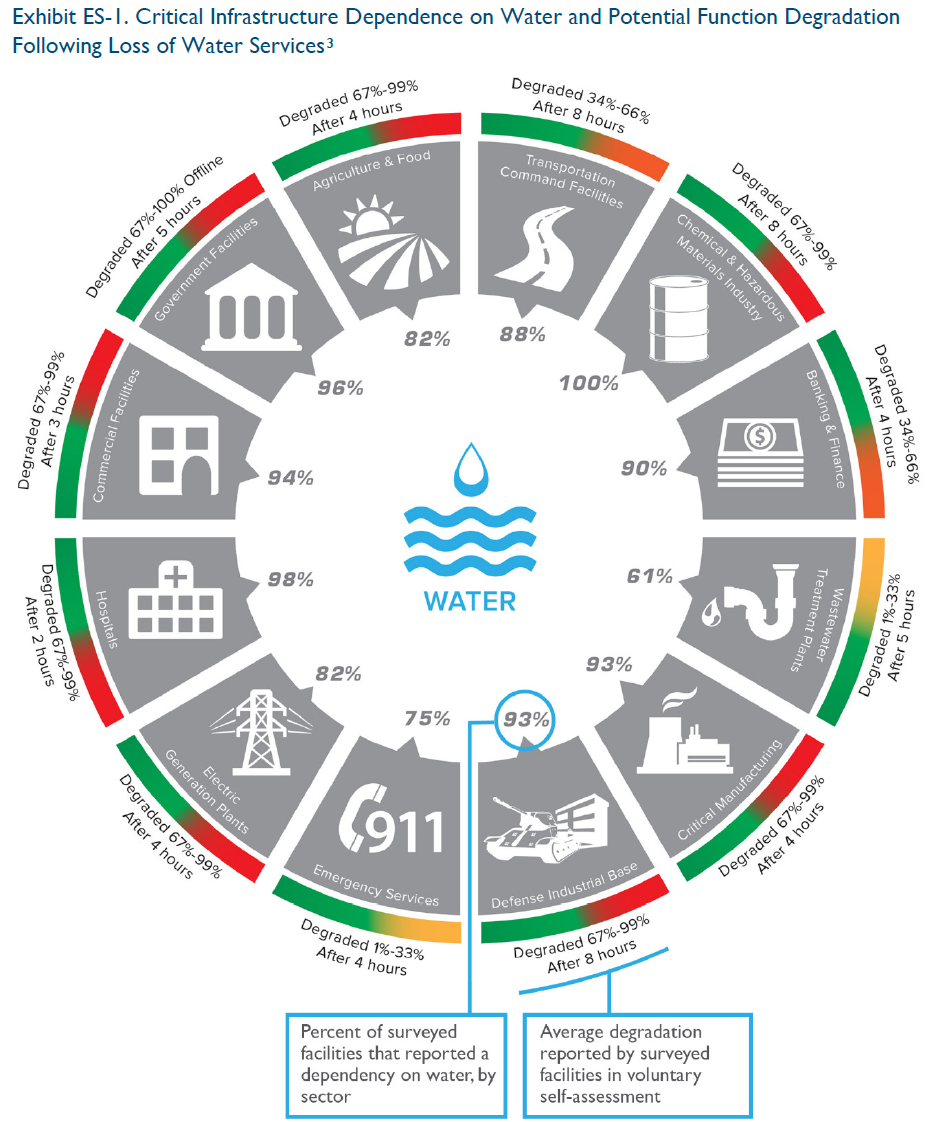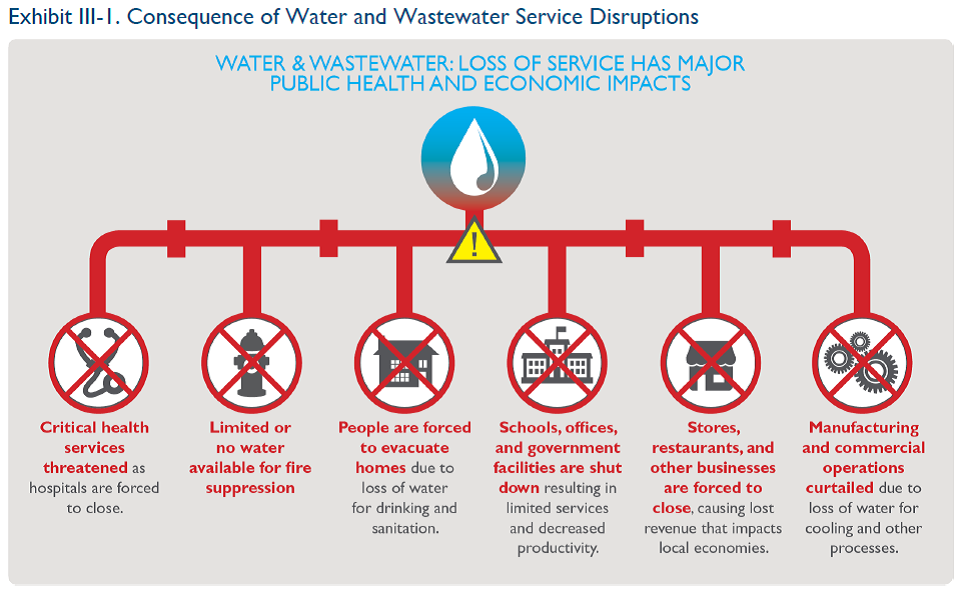“Water, water, everywhere, And all the boards did shrink; Water, water, everywhere, Nor any drop to drink . . . ” From the “Rime of the Ancient Mariner” by the 19th Century English Poet, Samuel Taylor Coleridge in his lengthy 1798 poem, once pondered by all who studied English Literature.
This sad tale originated the bad omen involving “an albatross around his neck,” reflecting the Mariner’s punishment after the crew blamed him for killing the bird as the cause of them being marooned at sea without wind to sail, deprived of fresh water and surrounded by undrinkable salt water. Click here for a brief summary of this classic story.
Without dwelling on the content and meaning of the Mariner’s story, this situation reminds me of the possible plight of Americans following the loss of the electric power grid for an indefinite period — which unless they have taken prior precautions could leave them without potable water. And today we have not taken those precautions.
Who/what would the survivors then blame for their most unwelcome condition?
Consider the alarming situation described by a recent National Infrastructure Advisory Council (NIAC) report on “Water Sector Resilience.” Click here for the full report and read at least the Executive Summary.
The NIAC advises the President on the security and resilience of the critical infrastructure sectors and their functional systems, physical assets and cyber networks. These sectors span the U.S. economy, including Water; Chemicals; Communications; Critical Manufacturing; Dams; Defense Industrial Base; Emergency Services; Energy; Financial; Food and Agriculture; Government Facilities; Healthcare and Public Health; Information Technology; Nuclear Reactors, Materials and Waste; and Transportation Systems.
As highlighted below in a figure from the Executive Summary of the NIAC report on water sector resilience, many of these sectors could be significantly degraded within a few hours after the loss of water, which could occur following a major loss of electricity — e.g., after an electromagnetic pulse (EMP) event and when diesel fuel used to power emergency generators runs out.
Moreover, the loss of water directly affects the health of citizens and their ability to survive. The NIAC reports that 92-percent of the U.S. population is served by 20-percent of the 51,000 Community Water Systems (CWSs). The other 8-percent of the U.S. population is served by CWSs that serve less than 3300 people each. More than 18,000 non-transient Non-CWSs serve schools, factories, office buildings and hospitals that have their own water systems. And there are 84,000 transient Non-CWSs at gas stations, campgrounds, and other places where people usually do not remain for long periods.
The NIAC report also provides a dismal picture of the situation for wastewater services. When water and wastewater services are lost, even for short periods, the consequences can be widespread and dramatic. When lost for an extended period, the results can be catastrophic as suggested below.
The NIAC report identified the Water/Wastewater sector as one of the “lifeline sectors” because its functions are essential to core operations in nearly every other critical sector. When lost even for a short period (less than eight hours) the functioning of multiple sectors is significantly degraded, as illustrated in the first figure above. Especially of concern is the impact on the Water/Wastewater sector when electricity, communications and transportation are disrupted. Key interdependencies include the:
- Chemical Sector — Chemicals are required to operate water/wastewater treatment facilities and water is often necessary in chemical manufacturing processes.
- Energy Sector — The Energy Sector relies on water services for different aspects of energy production and generation. The water sector relies on electricity to operate its pumps, treatment facilities, delivery systems and processing. Long-term power outages can overwhelm a water utility’s backup energy supply or deplete fuel reserves — a scenario made worse if the outage is systemic and multiple utilities in a region are shut down (as in an EMP event) or when multiple water utilities have to compete for scarce backup resources. The order in which disrupted sectors obtain energy services may be an issue as water utilities work to restore services.
- Communications and Information and Technology (IT) Sectors — These sectors rely on water services for equipment cooling and facility operations, while the Water Sector relies on Communications and IT for their operations and control systems, monitoring systems, internal communications, and communications with the public and emergency responders.
- Transportation Sector — Chemicals and other supplies are delivered by truck and rail. Water Sector personnel relay on transportation to get to and from work.
The NIAC report states that it is impossible to store sufficient backup water resources to maintain water-intensive operations in places such as hospitals, office buildings, chemical plants, generators and manufacturing facilities. Unlike electricity, water cannot easily be rerouted around disruptions, nor can facilities generate backup water onsite to maintain critical operations.
The rermainder of the NIAC report continues to review the conditions demonstrating the deterioration of capabilities throughout this critical “lifeline” sector — and the lack of current programs to repair the identified deficiencies. Key findings encompassing the challenges, needs and stratregies for improving security and resilience within the Water Sector were associafted with:
- Poor Understanding of the Criticality of the Water Sector
- Inadequate Valuation of Water Services
- Wide Disparity of Capabilities and Resources
- Significant Underinvestment in Water Resilience
- Fragmented and Weak Federal Support for Water Resilience
- Regional Collaboration Not Broadly Applied.
I again encourage our readers to consider at least the Executive Summary of the NIAC report, including for its abbreviated recommendations. A note of caution is that the conditions considered by the NIAC did not include the impact of a major shutdown of the electric power grid — which would assure catestrophic consequences, currently of indefinite duration.
When considering the impact of losing the water-wastewater sector, it is easy to understand why members of the EMP Commission testified that such a major loss of the electric power grid — which would lead to the loss of the water-wastewater sector and other key critical infrastructure — could lead to the death of most Americans within a year.
Clean water is vitally important for survival — and having sewage begin to back up within a day or so of lost power will lead to conditions that cause life threatening diseases. Chaos and societal collapse would no doubt follow the extended loss of water and wastewater, unless the current situation is rectified.
As with the Ancient Mariner, “Water, water every where, nor any drop to drink . . .” Unless we fix this mess, we too will deserve to have an albatross wrapped around our collective neck.
What can you do?
Join us in praying for our nation, and for a rebirth of the freedom sought, achieved and passed to us by those who came before us.
Help us to spread our message to the grass roots and to encourage all “powers that be” to provide for the common defense as they are sworn to do.
Begin by passing this message to your friends and suggest they visit our webpage www.highfrontier.org for more information. Also, please encourage your sphere of influence to sign up for our weekly e-newsletter.
Encourage them to review our past email messages, posted on www.highfrontier.org, to learn about many details related to the existential manmade and natural EMP threats and how we can protect America against them.
Click here to make a tax deductible gift. If you prefer to mail a check, Please send it to 500 North Washington Street, Alexandria, VA 22314.
E-Mail Message 160816
Please click here to read Past Weekly Updates!
Please help High Frontier continue this important and timely work!
Be sure to follow us on our Social Sites!
If you found this letter via our Social Sites, and you would like to subscribe, please click below!







